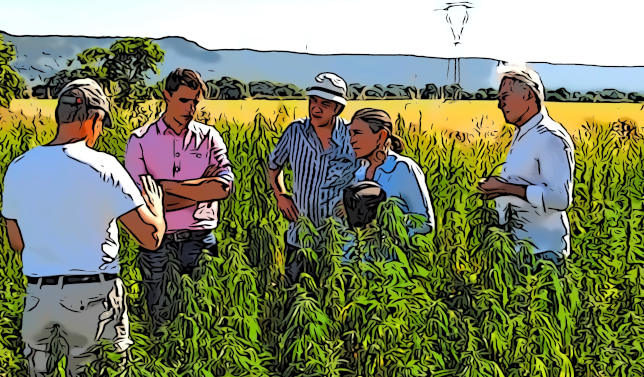On 5/30/19, the Supreme Court, Criminal United Sections, ruled on the hypothetical application of the Consolidated Narcotics Act (TUS) to the sale of industrial hemp. Referring specifically to leaves and inflorescences, oil and resin of Cannabis Sativa L. The ‘reasons’ for the ruling, however, confirm to us that it does not introduce anything new from the status quo. (1) It is just a big bluff, which has caused serious damage to honest operators in the supply chain.
Fishes for flasks
‘Fischi per fiaschi‘ is the solution to the cover rebus to the previous article where we commented on the ‘provisional interpretation no. 15‘ Of the judges of the Supreme Court. However, the latter were careful not to solve the rebus submitted to them. The ‘ermines’-so called because of the fur trim on their red velvet robes-have only made a Supreme confusion,
– between a plant, industrial hemp, which has been grown legitimately in Italy since the Middle Ages and is licensed throughout Europe precisely because it has no psychotropic effects
– and another plant, marijuana, which has a different genetic identity and completely different purposes of use.
The affair began with the seizure of 13 kilograms of leaves and inflorescences of a hemp variety of the second species, so identified due to the presence of the psychotropic active ingredient (tetrahydrocannabinol, THC) in a proportion above the maximum threshold allowed by Law 242/16 on industrial hemp plants (0.6 percent). As a result of the analysis, the investigating judiciary had seized the goods, which was validated by the G.I.P., and charged the crime of drug trafficking. (2)
The Court of Ancona, Re-examination Section, had then correctly lifted the preventive seizure ordered limited to the products found to contain an active ingredient content of no more than 0.6 percent. Noting that ‘only upon exceeding the 0.6 percent limit of active ingredient is it possible to seize and destroy the crop and thus also the derived product.’ However, the Public Prosecutor’s Office at the Ancora District Court had appealed the order of the review court in cassation.
The Supreme Court justices were faced with only one apparent conflict of norms:
– the nearly 30-year-old Consolidated Narcotics Act (TUS, Presidential Decree 309/90), which prohibits cultivation and sale of ‘cannabis and products made from it.’ Excluding, it should be noted, the ‘Hemp grown exclusively for fiber production or other industrial uses, other than those specified in Art. 27 [therapeutic use, following ministerial authorization] permitted under European Union regulations,’
– the recent Law 242/16, ‘Provisions for the promotion of the cultivation and agro-industrial chain of hemp,’ which regulates the cultivation and processing of industrial hemp. The law applies to varieties of Cannabis Sativa L. entered in the Common Catalogue of Agricultural Plants Authorized in Europe. (3) Which must therefore be understood to be excluded from the scope of the TUS, by express provision of Presidential Decree 309/90.
United Sections, the bluff of the ermines
The ermines in Rome – on closer inspection – decided nothing at all. By merely stating that ”from the cultivation of cannabis sativa L. no products other than those listed in Art. 2, Paragraph 2, Law no. 242 of 2016 and, in particular, leaves, inflorescences, oil, and resin.‘ Therefore, it is necessary to refer to subsection 2.2 of Law 242/16, the text of which we expressly refer to so that mules can also understand the permitted activities and products. The legislation, it should be noted, is applied only to Cannabis Sativa L. varieties listed in the European Catalog. (4) Which can be cultivated, it is reiterated, without any permission whatsoever. From them they can be obtained and marketed, according to the aforementioned standard:
‘(a) food and cosmetics produced exclusively in accordance with the disciplines of the respective fields;
(b) semi-finished products, such as fiber, canapulo, powders, wood chips, oils or fuels, for supplies to industries and handicrafts in various sectors, including the energy sector;
(c) material intended for green manure practice;
(d) organic material intended for bioengineering work or products useful for green building;
(e) material aimed at phytodepuration for the remediation of polluted sites;
(f) crops dedicated to educational and demonstration as well as research activities by public or private institutions;
(g) crops intended for floriculture’ (Article 2).
It follows that the same products mentioned by the United Sections-leaves, inflorescences, oil and resin-can be legitimately used and marketed for food and cosmetic purposes. It is worthwhile in this regard to elaborate on the legal status of different products:
– inflorescences and leaves are peacefully allowed in Europe as traditional foods, with herbal tea fate predominating. As well as as cosmetic ingredients,
– oil extracted from the inflorescences (by ethanol or supercritical CO2 ) is naturally rich in CBD, cannabidiol, a substance with no psychotropic effects. Some member states recognize its possible use in foods and food supplements, others consider Novel Food legislation should apply. The Commission confirms the divergence of views, without taking a position,
– the resins formed as a result of the CBD extraction process can in turn be mixed with hemp seed oil to supplement it with the residual cannabidiol in it and strengthen its flavor profiles,
– Hemp seed oil is a food of renowned value, which is distinguished by the optimal balance of Omega 3 and Omega 6, in a 3:1 ratio. And it is even recognized as a botanical ingredient for food supplements, by the Ministries of Health of France, Italy, and Belgium. Confirming not only the lawfulness of its use, but also its recognized health properties,
– hemp seeds and hemp flour, in turn, are already found on the shelves of supermarkets throughout Europe. With good reason, since it is a true superfood with about 25 percent protein and a ceiling of essential amino acids perhaps unique in completeness in the plant kingdom. As well as vitamins (A, B1, B2, B6, D, E), mineral salts (calcium, iron) and the polyunsaturated fatty acids mentioned in the previous paragraph.
Inoffensive hemp and the responsibility of the robes
Between the said and the unsaid, the Rome ermines actually recognized the full legitimacy of the above products. Specifying, on the other hand, that the production, possession, and marketing of only products other than those listed in Law 242/16-that is, for example, those derived from hemp varieties not listed in the Common Catalog-could constitute the offense under the Consolidated Narcotics Act. Provided, however, that the conduct is offensive in concrete terms, that is, the substances marketed are actually narcotics. Due, for example, to a high THC content. (5)
The United Sectionsthus recall that for the purposes of verifying the offensiveness of the conduct, exceeding the average daily dose is not relevant. Instead, we need to check whether the substance has a concrete ‘drugging effect’. As previously stated by the same United Sections, with regard to home cultivation. Moreover, the Ministry of Agriculture, Food and Forestry itself, in its circular 22.5.18, had reiterated the permissibility of cultivation of varieties listed in the ‘Common plant catalogue of varieties of agricultural plant species. (6)
Rather, the responsibility of the ermines for gross negligence in making a pronouncement of dubious constitutional legitimacy-having regard also to the applicable European rules, which in the hierarchy of sources of law have a superordinate role over the constitutional rules themselves-deserves to be explored. Taking into account that the ‘provisional interpretation‘ of the United Sections, later confirmed in the ruling under review, caused very serious damage to a supply chain that in Italy employs 10,000 workers in 1,500 companies, which make 150 million euros/year in turnover.
The big bluff has meanwhile already been overcome by the most recent order of the Criminal Court of Genoa, Re-examination Section, where justice and common sense prevailed over inexplicable Roman maneuvers.
#Égalité!
Dario Dongo
Notes
(1) See judgment 30.5.19 United Criminal Sections Court of Cassation http://www.cortedicassazione.it/cassazione-resources/resources/cms/documents/30475_07_2019_cannabis_no-index.pdf
(2) Presidential Decree No. 309/1990 (Testo Unico Stupacenti, TUS), Articles 73 paragraphs 1,2,4 and 80, paragraph 2
(3) Pursuant to Directive 2002/53/EC, Article 17.
(4) Noted for this purpose:
– Treaty on the Functioning of the EU (Art. 38 and All. I), where Cannabis Sativa L. (‘raw, ground, drawn, combed or otherwise prepared, but not spun hemp‘, v.d. 57.01) is qualified as an ‘agricultural’ product subject to European common policy,
– reg. EU 220/2015, where hemp is mentioned among ‘industrial plants‘ in relation to cultivation and seed production,
– reg. EU 1307/2013, laying down rules on direct payments to farmers under support schemes under the common agricultural policy, where it is specified that ”areas used for hemp production are eligible hectares only if the tetrahydrocannabinol content of the cultivated varieties does not exceed 0.2 percent’ (Art. 22.6)
(5) The principle of offensiveness is grounded in the Constitution of the Italian Republic, which, in Article 13, provides for the compression of the inviolable right of personal freedom only in function of the protection of a legal good of equal rank. The subsequent Article 27, in providing the criteria underlying criminal justice, postulates the recognizability of the objective disvalue of the wrongful act as being offensive to fundamental values of the system. In this regard, see also Constitutional Court, ruling 354/02
(6) Cf. Circ. MiPAAF 22.5.18. Clarification on the application of Law Dec. 2, 2016, no. 242
Dario Dongo, lawyer and journalist, PhD in international food law, founder of WIISE (FARE - GIFT - Food Times) and Égalité.




